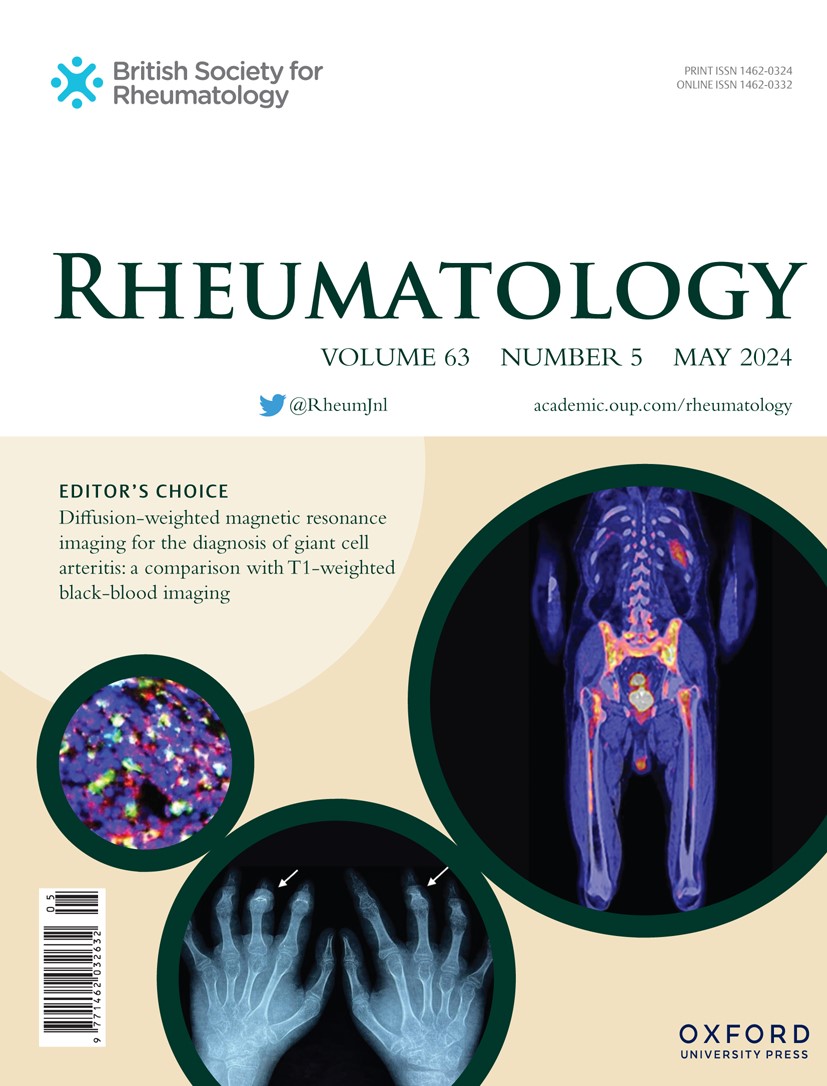P047 Enteroviral infection in autoimmune rheumatic diseases treated with anti-CD20 monoclonal antibodies
IF 4.7
2区 医学
Q1 RHEUMATOLOGY
引用次数: 0
Abstract
Background/Aims This case series describes two cases of CNS enteroviral infection in immunosuppressed patients with autoimmune rheumatic diseases (AIRDs). Enteroviral meningoencephalitis, a typically mild and self-limiting condition in immunocompetent individuals, can present as a severe, protracted illness with complex neurological manifestations in these patients. Immunosuppressants, particularly Anti-CD20 monoclonal antibodies (mAbs), can heighten the risk of complex enteroviral infection. Methods CASE 1 A 41-year-old female presented with an acute confusional state, headache, nausea and incoherent speech. She had background of granulomatosis with polyangiitis diagnosed 10 years previously and receiving mycophenolate and rituximab (last administered 4 months prior). On examination, she had a flat affect, reduced verbal fluency, brisk reflexes(3+) but without overt of meningism. Laboratory acute phase markers and neuroimaging investigations were normal. Electroencephalogram showed left temporal sharp waves, implying cortical irritation. Cerebrospinal fluid (CSF) revealed raised white cell count (WCC) 580 (0-5) with 99% lymphocytes and hyperproteinorrachia (>2g/L). CASE 2 A 27-year-old lady with systemic lupus erythematosus diagnosed in her teens presented with new neurological symptoms of slurred speech and vertigo. Neurological examination revealed right-sided nystagmus and ataxic gait. Two weeks preceding, she had had sequential admissions due to cough, nausea, vomiting, dizziness and persistent headache. She was diagnosed with right-sided vestibular neuritis at that time with evidence of enhancement in the posterosuperior aspect of the distal internal auditory meatus (IAM) on MRI brain and IAM. Due to active lupus nephritis, she was receiving multiple immunosuppressants including mycophenolate and with the recent addition of obinutuzumab 2 months prior. Given her progressive symptoms and immunosuppressed state, lumbar puncture was performed. CSF revealed elevated WCC of 44, predominantly lymphocytes and raised protein (800mg/dL). Results In both cases, CSF PCR was positive for enterovirus. Patients were diagnosed with enteroviral meningoencephalitis. They were treated with intravenous Immunoglobulin (IVIg). Although more often used in autoimmune encephalitis, IVIg has putative benefits iin viral encephalitis; potentially by increasing viral clearance by antibody-dependent neutralization and via a direct immunomodulatory action on CSF hyperinflammation and was used due to the lack of targeted antiviral treatments for enteroviruses. In the first case, the patient recovered after weeks but has residual headaches. In the second case, patient recovery was gradual with persistent speech impairment over months. Conclusion Enteroviruses are common causes of viral meningitis, but they can present atypically and more severely in immunocompromised individuals and should be considered in those patients presenting with neurological symptoms, even when typical signs of meningitis are absent. These cases demonstrate that enteroviral infections can lead to prolonged and debilitating illnesses in these patients. Diagnosis relies on CSF PCR testing, which is highly sensitive and specific for detecting enteroviruses. It remains challenging to find a delicate balance in managing immunosuppression to control autoimmune disease while mitigating the risk of opportunistic infections. Disclosure S. Tio: None. F. Zia: None. D. Costello: None. S. Moran: None. A. Jackson: None. G. Murphy: None.抗cd20单克隆抗体治疗自身免疫性风湿病肠病毒感染
背景/目的本病例系列描述了免疫抑制的自身免疫性风湿病(AIRDs)患者的两例中枢神经系统肠病毒感染。肠病毒性脑膜脑炎是免疫正常个体中一种典型的轻度和自限性疾病,但在这些患者中可表现为具有复杂神经系统表现的严重、长期疾病。免疫抑制剂,特别是抗cd20单克隆抗体(mab),可增加复杂肠病毒感染的风险。方法病例1,41岁女性,以急性精神错乱、头痛、恶心、语无伦次为主。10年前诊断为肉芽肿病伴多血管炎,并接受霉酚酸盐和利妥昔单抗治疗(最后一次用药是在4个月前)。检查时,患者情感平淡,语言流畅性下降,反应敏捷(3+),但无明显脑膜炎。实验室急性期指标及神经影像学检查均正常。脑电图显示左侧颞尖波,提示皮层刺激。脑脊液显示白细胞计数(WCC) 580(0-5)升高,99%淋巴细胞和高蛋白血症(>2g/L)。病例2:一名27岁的系统性红斑狼疮女性,十几岁时被诊断为系统性红斑狼疮,出现新的神经系统症状,言语不清和眩晕。神经学检查显示右侧眼球震颤和共济失调步态。两周前,她因咳嗽、恶心、呕吐、头晕和持续性头痛而连续入院。她当时被诊断为右侧前庭神经炎,MRI和IAM显示远端内耳道(IAM)后上侧增强。由于活动性狼疮性肾炎,她接受了多种免疫抑制剂,包括霉酚酸盐,并在2个月前加入了obinutuzumab。鉴于她的症状进展和免疫抑制状态,我们进行了腰椎穿刺。脑脊液显示WCC升高44,主要是淋巴细胞和蛋白升高(800mg/dL)。结果两例患者脑脊液PCR检测均为肠病毒阳性。患者被诊断为肠病毒性脑膜脑炎。静脉注射免疫球蛋白(IVIg)。尽管IVIg更常用于自身免疫性脑炎,但在病毒性脑炎中也被认为有益处;可能是通过抗体依赖性中和增加病毒清除率,并通过对脑脊液高炎症的直接免疫调节作用,由于缺乏针对肠道病毒的靶向抗病毒治疗而被使用。在第一个病例中,患者在几周后康复,但仍有头痛。在第二个病例中,患者的恢复是渐进的,持续了几个月的语言障碍。结论肠病毒是病毒性脑膜炎的常见病因,但在免疫功能低下的个体中可能表现为非典型和更严重的症状,即使没有典型的脑膜炎症状,也应在出现神经系统症状的患者中加以考虑。这些病例表明,肠道病毒感染可导致这些患者长期和衰弱性疾病。诊断依赖于脑脊液PCR检测,这对检测肠道病毒具有高度敏感性和特异性。在管理免疫抑制以控制自身免疫性疾病同时减轻机会性感染风险方面找到微妙的平衡仍然具有挑战性。S. Tio:没有。齐亚:没有。D.科斯特洛:没有。S.莫兰:没有。A.杰克逊:没有。G.墨菲:没有。
本文章由计算机程序翻译,如有差异,请以英文原文为准。
求助全文
约1分钟内获得全文
求助全文
来源期刊

Rheumatology
医学-风湿病学
CiteScore
9.40
自引率
7.30%
发文量
1091
审稿时长
2 months
期刊介绍:
Rheumatology strives to support research and discovery by publishing the highest quality original scientific papers with a focus on basic, clinical and translational research. The journal’s subject areas cover a wide range of paediatric and adult rheumatological conditions from an international perspective. It is an official journal of the British Society for Rheumatology, published by Oxford University Press.
Rheumatology publishes original articles, reviews, editorials, guidelines, concise reports, meta-analyses, original case reports, clinical vignettes, letters and matters arising from published material. The journal takes pride in serving the global rheumatology community, with a focus on high societal impact in the form of podcasts, videos and extended social media presence, and utilizing metrics such as Altmetric. Keep up to date by following the journal on Twitter @RheumJnl.
 求助内容:
求助内容: 应助结果提醒方式:
应助结果提醒方式:


